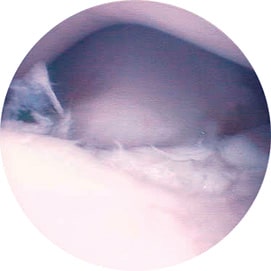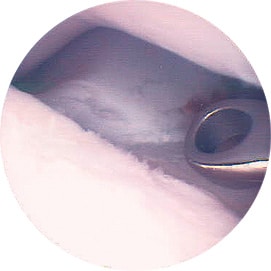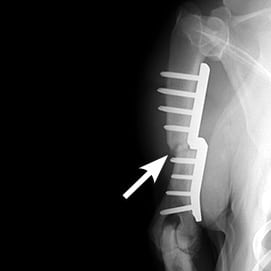
What is elbow dysplasia?
Elbow dysplasia means abnormal development of the elbow joint. This causes damage to the cartilage surface of the joint – a process called osteochondrosis or OCD. Elbow dysplasia and osteochondrosis collectively lead to the development of arthritis (osteoarthritis). Any of these three conditions may cause elbow pain.
Elbow dysplasia is a genetic disorder caused by the combination of genes from the parents (dam and sire). The exact detail of how the elbow develops abnormally is poorly understood. An uneven fit (or incongruency) is suspected and this results in abnormal distribution of weight within the joint. Points of increased pressure cause damage to the cartilage covering the bones, and fragmentation of cartilage and the underlying bone may develop (osteochondrosis).
What are the signs of elbow dysplasia?
Elbow dysplasia is a common condition, especially in large breed dogs. The key signs are fore limb lameness and stiffness. The latter is generally most evident after rest following exercise. Reduced weight-bearing on the limb and outward rotation of the paw may be evident.
Signs tend to develop when the dog is immature and growing (five to eight months of age) or when adult (perhaps a few years of age) due to osteoarthritis.
How is elbow dysplasia diagnosed?
Examination may reveal muscle wastage (atrophy). Manipulation of the elbow joints may cause increased pain. Swelling and restriction in range of movement may be evident.
X-rays (radiographs) are the most common method of diagnosing elbow dysplasia. They enable the presence and severity of secondary osteoarthritis to be assessed. The underlying elbow dysplasia and osteochondrosis are not always apparent. In some dogs no abnormalities are evident.
A CT scan is a form of X-ray that produces thin slices through the joint in any plane. These images can be reformatted to give a 3-D model of the joint. CT gives excellent detail of the shape (congruency) of the joint and enables detection of small bony fragments. Damage to the surface of the joint can be assessed by placing a small camera in the joint – this is called arthroscopic examination. It provides more detail of the joint surfaces than radiographs or a CT scan.

CT scans showing a fragment of bone in the elbow joint (arrows)
How can elbow dysplasia be treated?
Some dogs with elbow dysplasia can be managed satisfactorily without the need for surgery. Exercise often needs to be controlled to some degree. Each dog will have its own threshold of duration and type of activity beyond which elbow pain may increase. Hydrotherapy is often beneficial. Dogs that are overweight benefit from being placed on a diet. Tit-bits may need to be withdrawn and food portions reduced in size. Regular monitoring of weight may be necessary. Painkillers (anti-inflammatory drugs) may be indicated to make the dog more comfortable. Long-term drug therapy should be avoided if at all possible in view of potential side effects.
Dogs with elbow dysplasia that fail to respond satisfactorily to conservative treatment may need surgery. There are three key types of surgery: (1) fragment removal (2) incongruence surgery and (3) salvage surgery.

Fragments of cartilage and bone before removal

Fragments of cartilage and bone have been removed
-
Fragment removal surgery
This is the most common type of surgery for elbow dysplasia. It involves removing any loose fragments of cartilage and bone from the inside of the elbow joint. This can be done under guidance from a camera through a very small hole (arthroscopically) or via a direct surgical approach.
- Recovery, especially from arthroscopic surgery, tends to be reasonably rapid. Unfortunately, lameness fails to improve in a number of cases. This may be due to the underlying abnormal development of the joint (poor fit or incongruency) or the secondary osteoarthritis.
-
Incongruency surgery
Attempts may be made to improve the shape of the elbow joint and make it a better fit (or more congruent). This can be done by either removing the key pressure point within the joint or cutting the bone at the back of the joint (the ulna) to change the shape of the joint. Recovery from the latter procedure is slow and thus this surgery is reserved for a few selected cases.
-
Salvage surgery
Salvage surgery for elbow dysplasia is rarely necessary. However, occasionally the combination of elbow dysplasia, osteochondrosis and osteoarthritis cause persistent elbow pain that cannot be controlled by other more conservative means. In these few cases there are three surgical options; sliding humeral osteotomy (SHO), total elbow replacement (TER) and elbow joint fusion (termed arthrodesis).
Sliding humeral osteotomy is reserved for dogs where the outer part of the elbow joint (the lateral compartment) is relatively healthy compared to the inner part of the joint (the medial compartment) where the majority of damage tends to be. The bone of the forearm (the humerus) is cut and realigned in such a way that more weight is transferred through the outer, healthy part of the joint and less through the inner, diseased part of the joint. A special plate with a ‘step’ is applied to the inside of the bone. Although recovery from surgery can be slow, the majority of dogs improve and have less elbow pain. There are possible complications, for example, breakage of the plate or screws.

X-rays showing a sliding humeral osteotomy (SHO). The bone above the elbow has been cut, re-aligned (arrow) and stabilised with a special plate
Fusion or arthrodesis of the elbow joint results in a pain-free limb, but limb, function is compromised – since the elbow no longer moves, dogs tend to have to swing their limb around, rather than straight forward, in order to walk.
What is the outlook with elbow dysplasia?
The outlook or prognosis with elbow dysplasia and the associated osteochondrosis/osteoarthritis is quite variable. Some dogs can be managed successfully with conservative treatment involving modification of exercise and weight, with or without the need for anti-inflammatory painkiller drugs. Others benefit from removal of cartilage and bone fragments or surgery to improve joint congruency. The majority of dogs lead satisfactory lives, although their exercise and weight may need to be closely monitored. A degree of stiffness and lameness, especially after exercise, is not uncommon. In a small minority of cases that fail to respond satisfactorily to conservative procedures, salvage surgery, such as sliding humeral osteotomy or total elbow replacement, may need to be considered.
If you have any queries or concerns, please do not hesitate to contact us.
Arranging a referral for your pet
If you would like to refer your pet to see one of our Specialists please visit our Arranging a Referral page.